
Luca Giordano was an Italian late-Baroque painter and printmaker in etching. Fluent and decorative, he worked successfully in Naples, Rome, Florence, and Venice, before spending a decade in Spain.

Sacrificial Scene is a grisaille tempera on canvas painting by Pontormo, produced around 1520 and now in the National Museum of Capodimonte in Naples. It was probably originally produced as part of the decoration of an interior in honour of Cosimo de' Medici.

Penitent Magdalene is a c. 1550 oil on canvas painting by Titian, now in the Museo di Capodimonte in Naples.

Portrait of Cardinal Alessandro Farnese is a c. 1545 – 46 oil on canvas three-quarter-length portrait of Alessandro Farnese the Younger (1520–1589) by Titian, now in the Museo nazionale di Capodimonte in Naples.

Penitent Magdalene is a 1618-1623 oil on canvas painting by Jusepe de Ribera, now in the Museo nazionale di Capodimonte in Naples.

Madonna of Constantinople is a c. 1656 oil on canvas painting by Mattia Preti. It was the first of many works commissioned as ex-votos for freeing the city from the plague of 1656 – they all showed the Madonna with a selection of the city's patron saints, in this case Joseph, Januarius, Roch, Nicasius and Rosalia (centre). It now hangs in the Museo nazionale di Capodimonte in Naples.

Portrait of Pope Paul III with Camauro is a 1545 – 1546 oil on canvas painting by Titian, now in the Museo nazionale di Capodimonte in Naples.

The Earthly Trinity with Saints and God the Father are a pair of c.1626-c.1635 oil on canvas paintings by Jusepe de Ribera, both now in the Museo nazionale di Capodimonte in Naples. Along with the Holy Family, the main work shows Bruno of Cologne, Benedict of Nursia, Bernardino of Siena and Bonaventure.

Saint John the Baptist is a c.1653-1656 oil on canvas painting by Mattia Preti, now in the Museo nazionale di Capodimonte in Naples.
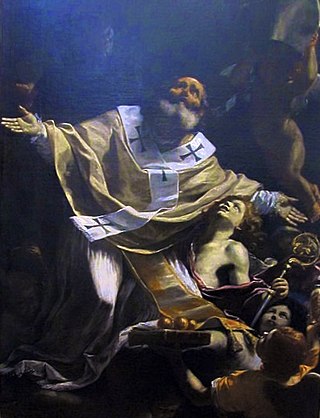
Saint Nicholas is a c. 1653 painting by Mattia Preti, the first work he produced after moving to Naples and showing the three gold balls which are a traditional attribute of the saint. It is now in the Museo nazionale di Capodimonte in the same city. He also produced a larger version of the work in 1657 which is now in the Pinacoteca civica in Fano, with an early copy after the Capodimonte version now in the church of Santa Teresa degli Scalzi in Naples.

The Banquet of Absalom is an oil on canvas painting by Mattia Preti, created in c. 1660–1665, now in the Museo nazionale di Capodimonte in Naples. It illustrates a passage from chapters 13 and 14 of 2 Samuel in the Old Testament, in which King David's son Absalom avenges the rape of Absalom's sister Tamar two years earlier by inviting her rapist Amnon to a feast, getting him drunk and then killing him.
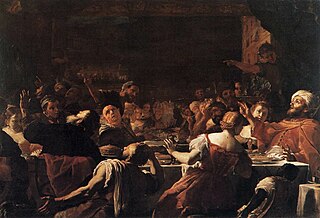
Belshazzar's Feast is a circa 1660-1665 oil on canvas painting by Mattia Preti, now in the Museo nazionale di Capodimonte in Naples. It shows a scene from chapter 5 of the Book of Daniel.

The Return of the Prodigal Son is a 1656 oil on canvas painting by Mattia Preti, now in the Museo nazionale di Capodimonte in Naples.

The Return of the Prodigal Son is a c. 1658 oil on canvas painting by Mattia Preti, now in the Royal Palace of Naples.
Apollo and Marsyas is the name of the following paintings:
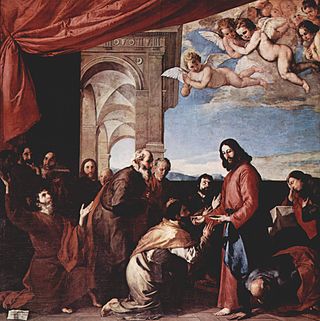
The Last Supper or The Communion of the Apostles is a 1651 oil on canvas painting by Jusepe de Ribera, still in the choir of the Certosa di San Martino in Naples, for which it was commissioned.
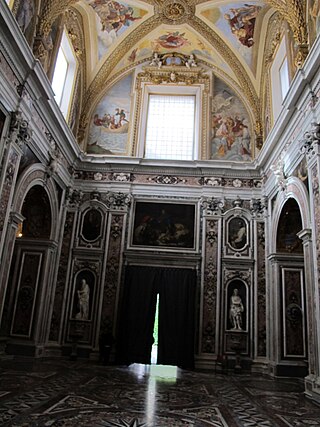
Prophets and Patriarchs is a series of fourteen oil on canvas paintings produced between 1638 and 1643 by Jusepe de Ribera along the nave walls of the church of the Certosa di San Martino in Naples, where they still hang. Moses and Elijah hang behind the west facade, whilst the rest hang under the arches of the side chapels.
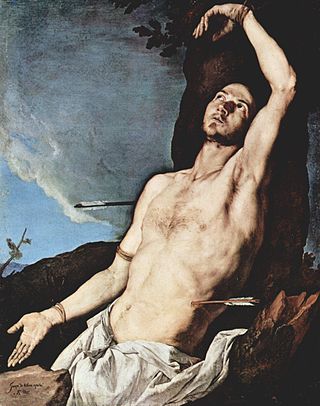
Saint Sebastian is a 1651 oil on canvas painting by Jusepe de Ribera. With Saint Bruno Receiving the Rule and Saint Jerome, it is one of three works commissioned from him for the private quarters of the prior of the Certosa di San Martino in Naples, where they still hang. A work of his second maturity, it is a second version of a 1636 work now in Madrid.

The Flagellation of Christ is a c.1618 oil on canvas painting by Jusepe de Ribera, from the start of his stay in Naples. A smaller autograph copy without the accompanying figure on the right is now in the Galleria Sabauda in Turin.

Apollo and Marsyas is a 1637 oil on canvas painting by Jusepe de Ribera, now in the Museo nazionale di Capodimonte in Naples. Heavily influenced by Caravaggio, he produced another version, also in 1637, now in the Royal Museums of Fine Arts of Belgium in Brussels.



















